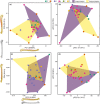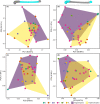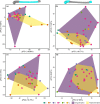Phylogeny and foraging behaviour shape modular morphological variation in bat humeri
- PMID: 33372711
- PMCID: PMC8128765
- DOI: 10.1111/joa.13380
Phylogeny and foraging behaviour shape modular morphological variation in bat humeri
Abstract
Bats show a remarkable ecological diversity that is reflected both in dietary and foraging guilds (FGs). Cranial ecomorphological adaptations linked to diet have been widely studied in bats, using a variety of anatomical, computational and mathematical approaches. However, foraging-related ecomorphological adaptations and the concordance between cranial and postcranial morphological adaptations remain unexamined in bats and limited to the interpretation of traditional aerodynamic properties of the wing (e.g. wing loading [WL] and aspect ratio [AR]). For this reason, the postcranial ecomorphological diversity in bats and its drivers remain understudied. Using 3D virtual modelling and geometric morphometrics (GMM), we explored the phylogenetic, ecological and biological drivers of humeral morphology in bats, evaluating the presence and magnitude of modularity and integration. To explore decoupled patterns of variation across the bone, we analysed whole-bone shape, diaphyseal and epiphyseal shape. We also tested whether traditional aerodynamic wing traits correlate with humeral shape. By studying 37 species from 20 families (covering all FGs and 85% of dietary guilds), we found similar patterns of variation in whole-bone and diaphyseal shape and unique variation patterns in epiphyseal shape. Phylogeny, diet and FG significantly correlated with shape variation at all levels, whereas size only had a significant effect on epiphyseal morphology. We found a significant phylogenetic signal in all levels of humeral shape. Epiphyseal shape significantly correlated with wing AR. Statistical support for a diaphyseal-epiphyseal modular partition of the humerus suggests a functional partition of shape variability. Our study is the first to show within-structure modular morphological variation in the appendicular skeleton of any living tetrapod. Our results suggest that diaphyseal shape correlates more with phylogeny, whereas epiphyseal shape correlates with diet and FG.
Keywords: Chiroptera; foraging ecology; functional morphology; geometric morphometrics; humerus; modularity.
© 2020 Anatomical Society.
Figures







Similar articles
-
Variation in cross-sectional shape and biomechanical properties of the bat humerus under Wolff's law.Anat Rec (Hoboken). 2021 Sep;304(9):1937-1952. doi: 10.1002/ar.24620. Epub 2021 Mar 24. Anat Rec (Hoboken). 2021. PMID: 33724719
-
Beyond head and wings: Unveiling influence of diet, body size, and phylogeny on the evolution of the femur in phyllostomid bats.Anat Rec (Hoboken). 2025 Mar;308(3):930-945. doi: 10.1002/ar.25551. Epub 2024 Aug 2. Anat Rec (Hoboken). 2025. PMID: 39095996
-
Wing morphology predicts individual niche specialization in Pteronotus mesoamericanus (Mammalia: Chiroptera).PLoS One. 2020 May 11;15(5):e0232601. doi: 10.1371/journal.pone.0232601. eCollection 2020. PLoS One. 2020. PMID: 32392221 Free PMC article.
-
Bat flight: aerodynamics, kinematics and flight morphology.J Exp Biol. 2015 Mar;218(Pt 5):653-63. doi: 10.1242/jeb.031203. J Exp Biol. 2015. PMID: 25740899 Review.
-
Adaptive evolution of butterfly wing shape: from morphology to behaviour.Biol Rev Camb Philos Soc. 2019 Aug;94(4):1261-1281. doi: 10.1111/brv.12500. Epub 2019 Feb 21. Biol Rev Camb Philos Soc. 2019. PMID: 30793489 Review.
Cited by
-
Evolutionary integration of forelimb and hindlimb proportions within the bat wing membrane inhibits ecological adaptation.Nat Ecol Evol. 2025 Jan;9(1):111-123. doi: 10.1038/s41559-024-02572-9. Epub 2024 Nov 1. Nat Ecol Evol. 2025. PMID: 39487310
References
-
- Adams, D.C. (2014) A generalized K statistic for estimating phylogenetic signal from shape and other high‐dimensional multivariate data. Systematic Biology, 63, 685–697. - PubMed
-
- Adams, D.C. & Collyer, M.L. (2018a) Multivariate phylogenetic comparative methods: evaluations, comparisons, and recommendations. Systematic Biology, 67, 14–31. - PubMed
-
- Adams, D.C. & Collyer, M.L. (2018b) Phylogenetic ANOVA: Group‐clade aggregation, biological challenges, and a refined permutation procedure. Evolution, 72, 1204–1215. - PubMed
-
- Adams, D.C. , Collyer, M.L. , Kaliontzopoulou, A. & Sherratt, E. (2017) Geomorph: software for geometric morphometric analyses. R package. Available at:https://cran.r‐project.org/package=geomorph
-
- Adams, D.C. , Otárola‐Castillo, E. & Paradis, E. (2013) Geomorph: an R package for the collection and analysis of geometric morphometric shape data. Methods in Ecology and Evolution, 4, 393–399.
Publication types
MeSH terms
LinkOut - more resources
Full Text Sources
Research Materials

